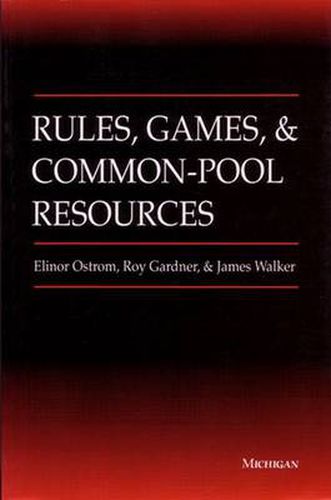Readings Newsletter
Become a Readings Member to make your shopping experience even easier.
Sign in or sign up for free!
You’re not far away from qualifying for FREE standard shipping within Australia
You’ve qualified for FREE standard shipping within Australia
The cart is loading…






While the tragedy of the commons is real, there are many instances where institutions develop to protect against overexploitation. In this important work, the authors explore empirically, theoretically, and experimentally the nature of such institutions and the way they come about.
Forests, irrigation systems, fisheries, groundwater basins, grazing lands, and the air we breathe are all examples of common-pool resources (CPRs). Because no one has property rights or control over such a resource, users of CPRs are frequently assumed to be caught in an inescapable dilemma - overexploitation of the resource, or what is commonly known as the tragedy of the commons. Many well-documented examples of overexploitation exist. The users of commonly held resources have, however, in many instances overcome incentives to destroy the resources and have developed long-enduring institutions that enabled them to utilize these resources more effectively. Understanding the conditions under which users of CPRs successfully develop and maintain effective institutions is critical to facilitating improved resource policies.
Using the analytic tools of game theory and institutional analysis and an empirical foundation based on controlled laboratory experiments and field data, this book explores endogenous institutional development. Specifically, this research focuses on three questions. In CPR dilemmas, to what degree are the predictions about behavior and outcomes derived from noncooperative game theory supported by empirical evidence? Where behavior and outcomes are substantially different from the predicted, are there behavioral regularities that can be drawn upon in the development of improved theories? What types of institutional and physical variables affect the likelihood of successful resolution of CPR dilemmas?
This is a work of important relevance to all studying environmental issues from a wide variety of disciplinary perspectives.
$9.00 standard shipping within Australia
FREE standard shipping within Australia for orders over $100.00
Express & International shipping calculated at checkout
While the tragedy of the commons is real, there are many instances where institutions develop to protect against overexploitation. In this important work, the authors explore empirically, theoretically, and experimentally the nature of such institutions and the way they come about.
Forests, irrigation systems, fisheries, groundwater basins, grazing lands, and the air we breathe are all examples of common-pool resources (CPRs). Because no one has property rights or control over such a resource, users of CPRs are frequently assumed to be caught in an inescapable dilemma - overexploitation of the resource, or what is commonly known as the tragedy of the commons. Many well-documented examples of overexploitation exist. The users of commonly held resources have, however, in many instances overcome incentives to destroy the resources and have developed long-enduring institutions that enabled them to utilize these resources more effectively. Understanding the conditions under which users of CPRs successfully develop and maintain effective institutions is critical to facilitating improved resource policies.
Using the analytic tools of game theory and institutional analysis and an empirical foundation based on controlled laboratory experiments and field data, this book explores endogenous institutional development. Specifically, this research focuses on three questions. In CPR dilemmas, to what degree are the predictions about behavior and outcomes derived from noncooperative game theory supported by empirical evidence? Where behavior and outcomes are substantially different from the predicted, are there behavioral regularities that can be drawn upon in the development of improved theories? What types of institutional and physical variables affect the likelihood of successful resolution of CPR dilemmas?
This is a work of important relevance to all studying environmental issues from a wide variety of disciplinary perspectives.